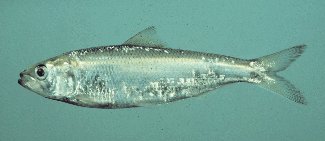Fish Iowa - Fish Species - Alabama Shad

Characteristics
A slender, streamlined fish with bluish or greenish upper parts with silvery reflections, shading to silvery-white on its side and belly. Body depth goes about four times its length. Dorsal fin with 16 to 18 (usually 17) rays; the last ray of the dorsal fin is not prolonged into a slender filament. It has a large terminal mouth with black pigments along most of its length; the lower jaw does not extend past the upper jaw. Only the young have jaw teeth; tongue with small teeth preset in a single median row. The first gill arch has more than 30 gill rakers along the lower half.
Foods
Adults do not eat while in freshwater, but the young eat small fish and aquatic insects.
Expert Tip
- No results found
Details
As an anadromous species, the Alabama Shad spends most of its adult life in the sea, but spawns in riverine systems. Spawning usually occurs in large, permanent streams, with moderate currents and sand and gravel substrates. In Missouri it occurs in swift water around rock wing dikes or over rocky shoals. The Alabama Shad was widespread throughout Tennessee in pre-impoundment days, but is now on Tennessee’s list of rare vertebrates. It continues to decline in the Pearl River system of Louisiana and Alabama. Local researchers report the Alabama Shad as rare in Ohio and Kentucky.
Since this species has not been collected in Iowa in nearly a century, it is presumed to be extirpated in Iowa.
Sources:
Harlan, J.R., E.B. Speaker, and J. Mayhew. 1987. Iowa fish and fishing. Iowa Conservation Commission, Des Moines, Iowa. 323pp.
Loan-Wilsey, A. K., C. L. Pierce, K. L. Kane, P. D. Brown and R. L. McNeely. 2005. The Iowa Aquatic Gap Analysis Project Final Report. Iowa Cooperative Fish and Wildlife Research Unit, Iowa State University, Ames
Pflieger, W.L. 1997. The fishes of Missouri. Missouri Department of Conservation, Jefferson City, Missouri. 372 pp.
Photo credit: Photo courtesy of Garold W. Sneegas, copyright Garold W. Sneegas, Aquatic Kansas Images. http://www.nanfa.org/akiweb/AKI.htm
Distribution Map

Fishing is not allowed for this species.
If you catch this species, immediately return it to the water with as little injury as possible.